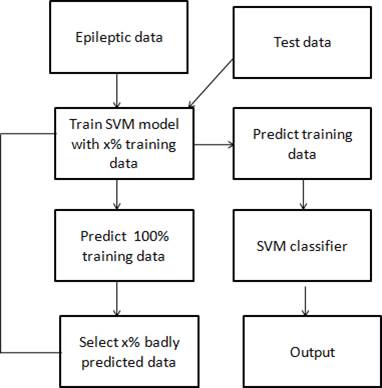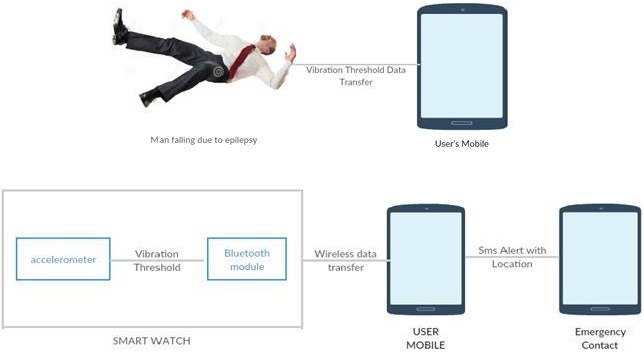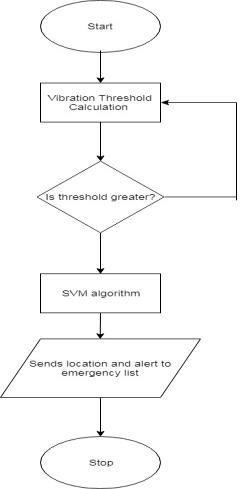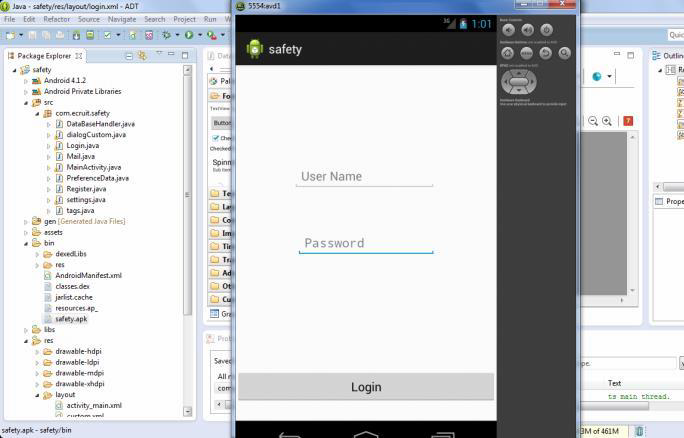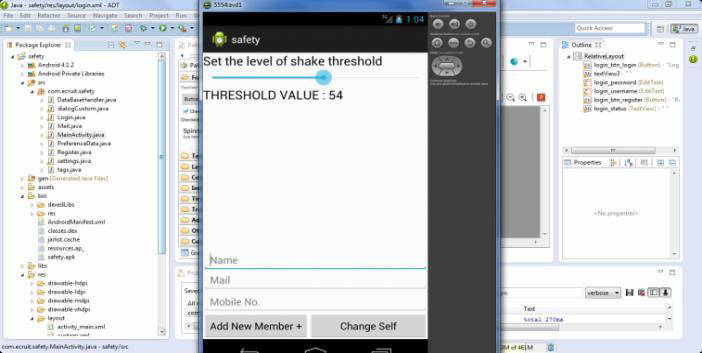1. Introduction
Epilepsy is one of the most common neurological disorders and there are around 60 million people with epilepsy in the world. It is the seventh leading cause of death and a major cause of heart, stroke, kidney failure and various other complications. Consequently there are many research work proceeded for prediction and treatment analysis. While there are many approaches for epilepsy detection using IoT and accelerometry and several include machine learning techniques such Hidden Markov Model and Artificial neural network for the classification. Wearable health-monitoring systems (WHMS) have drawn a lot of attention from the research community and the industry during the last decade as it is pointed out by the numerous and yearly increasing corresponding research and development efforts. As healthcare costs are increasing and the world population is ageing. There has been a need to monitor a patient’s health status while he is out of the hospital in his personal environment. To address this demand, a variety of system prototypes and commercial products have been produced in the course of recent years, which aim at providing real-time feedback information about one’s health condition. To overcome the problem in that existing system, we have implemented the smart phone sensor system using accelerometer and SVM machine learning algorithm. This complete system works on a cell phone having software installed in it with accelerometer. The program calculates the sensor reading and matches with the fed in data in the software, if match found then an alert will give to emergency contact in the system and also a text message will be sent asking for help with location details so that the patients are saved at the earliest. The implementation of this concept depends upon awareness among patients and doctors, by introducing the proposed system into medical field; it improves accurate prediction and treatment analysis.
2. Literature survey
The survey done on related articles suggest that machine learning algorithms have made its advancements in almost all the commercial zones. Prediction of seizure has been implemented using many machine learning algorithms. This paper will investigate the application of current state of the art of wireless sensing element in health care systems and will address how Wireless Sensor concepts are integrated in our computer engineering program. Advances in wireless sensor devices have unfolded new opportunities in attention systems. Most of the sensor based technology has invaded medical devices to change to thousands of wires connected to these devices found in hospitals. This technology has the potential of providing dependency in addition to increased quality. Pantelopoulos and Bourbakis (2010). But the used of EHIP-HOP method to a real time environment is proposed for the potential use of mobile wireless sensor networks. The application of mobile wireless sensing elements includes military, healthcare, robotics, vehicle monitoring and monitoring of environment and industries. This paper discusses about the healthcare monitoring system, its challenges, potential threats which affect the performance of healthcare monitoring system by one of the methods proposed namely EHIP-HOP method. This method requires lots of wiring process which is not liable for portability. Vandecasteele et al. (2010). But the utilization of wearable biosensor systems for observance has garnered scores of attention within the scientific community during the last years. The biosensor systems embrace differing types of physiological sensors, transmission modules and processing capabilities, which facilitate low-cost wearable solutions for all- day and any-place health status monitoring. This paper attempts to review the current research and development on wearable biosensor systems for health monitoring. The costs of these biosensor devices are too high thus these systems are not affordable for lower- and middle-class people. Vergara, De La Cal, Villar, González, and Sedano (2017). Another methodology which is in use is Electrocardiography which has added value to automatically detect seizures in temporal lobe epilepsy patients. This system consists of electrocardiography and photo plethysmography technologies which are compared along with the hospital ECG machines to predict the occurrence of seizure using seizure detection algorithm. This methodology does not have accurate classifications on seizure and thus cannot be used for alerting systems. Borujeny, Yazdi, Keshavarz-Haddad, and Borujeny (2013).The Electroencephalogram is widely recognized for diagnosing and assessing brain activities and disorder. The study utilized an EEG datasets that is used in various researches regarding epilepsy detection. The processed EEG signals are used to decompose the signals into five sub bands within which only the Delta sub band is used for further processing. But the use of EEG is further more minimized into wrist watches. The goal of this study was to determine if a wrist-worn motion detector could detect seizures. Individuals admitted for continuous video/EEG monitoring wore a wristwatch-size device that was programmed to detect rhythmic movements such as those that occur during seizures. When such movement was detected, the device sent a Bluetooth signal to a computer that registered the time and duration of the movements. Although this method is accurate, it is not comfortable for the patient as the EEG-electrodes have to be attached to the scalp which hampers the patient's movement. This makes long-term home monitoring not feasible. In this paper, the aim is to propose a seizure detection system based on accelerometer for the detection of epileptic seizure. The sensors used are wireless, which can improve quality of life for the patients. In this system, 3 2D accelerometer sensors are positioned on different parts of an epileptic patient. A wireless, remote observance system acting with a single wrist-worn accelerometer sensor was developed, that is sensitive to multiple sorts of convulsive seizures and is capable of detecting seizures with short duration. Simple time domain features including a new set of Poincare plot based features were extracted from the active movement events recorded using a wrist-worn accelerometer sensor.
3. Objective
The International Bureau for Epilepsy states that Epilepsy is one of the major common serious diseases affecting more than 50 million people globally. There are many different causes for epilepsy including genetic disorders, head trauma and brain tumour. In the world where the Wearable health-monitoring systems (WHMS) have drawn a lot of attention from the research community and the industry during the last decade as it is pointed out by the numerous and yearly increasing corresponding research and development efforts. Hence we have proposed a system for Monitoring and detecting seizure and epilepsy. We perform accelerometry technique along with Machine Learning algorithm for the prediction of seizure using Support vector Machine Algorithm. It consists of user friendly Android Application along with a smart watch for detecting the vibration level of the patients. If there is any emergency and if there is vast difference in the vibration levels of the patient, the patient details along with the location details are sent immediately from the remote place. This predictive analysis can be used to make decisions for the doctors with accuracy and can help the patients at the earliest. Thus this proposed system enables great accuracy of output which is indispensible for a medical diagnosis.
4. Methodology
The system uses Support Vector Machine algorithm to predict whether the person is suffering from epilepsy and helps to classify different type seizure the patient undergoes. The GUI is developed to create user friendly advantage for the patients even assists in the absence of doctors to get accurate test results. The system consists of a android application and a smart watch along with inbuilt accelerometer and Bluetooth module. The mobile application is already fed with different vibration levels that happen in human body. The smart watch is worn by the person and it monitors the vibration level that occur in human body and send it to mobile application to predict epilepsy. The maximum threshold vibration is calculated and compared with the pre-existing data in mobile application using Support Vector Machine (SVM) algorithm. If the threshold doesn’t match with the pre-existing data then the system generated the location of the person and sends an alert message along with location to the emergency contact
4.1. Algorithm
4.1.1. Support vector machine algorithm
The Machine learning algorithms show excellent performance for the epilepsy diagnosis. Support Vector Machine is one such supervised machine learning algorithm used in medical research for classification and regression. The dataset is multivariate and it is converted into numeric and is
It consists of a group of SVMs each trained with a different set of weights between the epilepsy affected patient and epilepsy not affected patient data.
It involves mapping the inputs into high- dimensional feature spaces. And it denoted by separating hyper planes. For the classification, the target variable is either 0 or 1. The 0 denotes whether the patient is not affected by epilepsy. The binary 1 denotes the patient is affected by epilepsy.
This model helps in terms of high performance, high execution time, accuracy and error rate. Support vector machine algorithm works well with R language.
For linear kernel,
f(x) = |
B(0) + sum(ai * (x,xi)) For |
polynomial with exponential, K(x,xi) = |
1 + sum(x * xi)^d |
K(x,xi) = |
exp(-gamma * sum((x - xi²)) |
This algorithm helps us predict the results of epileptic patients in an efficient way. The training and testing is fed into the model. The SVM model checks for x% percent of training dataset and if they are badly predicted they are again fed into the model for training and the test data are compared with the training dataset to predict the output. The Architecture is shown in Fig. 1.
5. Implementation
The foremost idea of the model is to predict the seizure caused by epileptic motion of body and provide immediate aids or alerts based on machine learning algorithm. A user friendly mobile application is created for the patients to enter the parameters required for the detection of seizure along with the personal data. The mobile application consists of a basic registration page for the user to have basic notifications from the application. The application also has a login page for future logging. Once after logging the user is taken to a emergency contact filling page where the user have to give the list of emergency contact details. All the contacts given are stored in the mobile application.
Threshold levels of various vibrations that occur in the body are taken and fed in to the mobile application. A wearable device consisting of accelerometer sensor is used along with this mobile application to calculate the threshold generated due to the vibration created in the body by seizure. Both the mobile application and the wearable device are always connected via Bluetooth or Wi-Fi. When there is a vibration in the body the accelerometer sensor senses the vibration and calculates the threshold generated for that vibration. And the collected threshold data is then sent to the mobile application for initial level of checking. When the threshold crosses the minimum level vibration of body then the threshold data is used to calculate the differences of that particular threshold value and the preexisting threshold data which is already fed in the application. For the better analysis, the data is stored in the cloud for the future retrieval. We use Support vector machine technique to identify the difference for the generated threshold and the pre-existing threshold value. The data is preprocessed and normalization is performed for better results. Using this algorith we can henceforth predict the seizure activity in the body and the alerts for the emergency contacts are sent. When the application detects seizure in body is takes the present latitude and longitude values of the mobile and sends it along message to the emergency numbers. The mobile application is also featured to track the current location of the victim's mobile which helps the caretaker to easily locate the victim. The flow of the system is shown in Fig. 2. Implementation flow is shown in Fig. 3.
6. Results and predictions
As mentioned, the user login page is used to login to the application. The emergency contacts add page has three parameters namely the contact's name, mail and phone number. The mail address and the phone number are used to send the alert messages. After adding the contact details are stored in the application for future use and the application displays the name of the contact that are stored. The threshold page has a default threshold value setup which acts as a basic threshold to calculate the received threshold value. The wearable device has accelerometer which helps in generating threshold value for the vibrations that are created in the body. The generated threshold value is transferred to the application via Bluetooth or Wi-Fi. The transferred threshold is calculated with the given basic threshold value. When the comparison does not match then the transferred data is classified with the fed in threshold data using support vector machine algorithm. The algorithm classifies the continuously generating threshold and predicts the occurrence of seizure in the body. After predicting the geographical status of the mobile is taken by the application. The generated geographical status is then shared with the emergency contacts which is stored in the application. This data is sent along with an emergency message to the receiver. The application also creates an alarm to alert the public about the incident. From the next minute of sending the alert message, the victim’s mobile location is turned on which enables the receiver to track the victim’s location. The result is shown in Fig. 4.
7. Conclusions
In our country many people suffer from seizure attack and it has become one the major diseases which can cause many complications. Prediction of seizure and analysis using machine learning helps in revolution in the medical field and worthy studying rather than the traditional methods. Here we come up with the new idea of seizure prediction and utilize immediate safety measures to help the victims. This concept will be a benchmark in the medical field due to its reliability and accuracy. Here we use Support vector machine algorithm which enables us to predict the accurate results for the patients and helps them with accurate immediate safety measures which becomes the novelty. This concept makes tremendous impact in medical field to reach new level and also makes more profitable for the patients. The proposed system is being modeled such that the parameters are collected from the patients. The data is being sent to cloud for data storage and access. From the cloud the data is being formulated in such a way that it is sent to series of algorithmic calculations for predictions. Classification maps are generated with frequent data patterns being visualized. The implementation with Eclipse for analysis and software tool as Tableau produces visualized results. This concept mainly depends upon creating awareness to the patient, because it can be easily implemented and visualized due to its numerous advantages. The visualized patterns there-by on further analysis on helps the patients for re-modeling a prediction system which is the overall objective of the proposed system. Hence the outcome of decision making for prediction re-modeling using analytical predictions is given in this proposed system. Further, the same system can be customized for specific requirements and with help of predictions the overall safety measures for the patient in specific can be visualized.











 nueva página del texto (beta)
nueva página del texto (beta)

